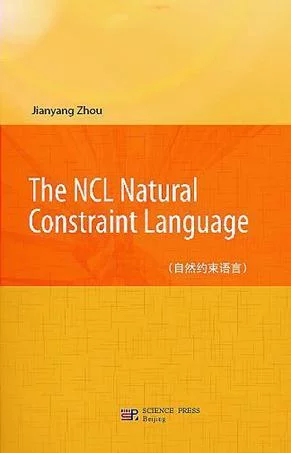自然约束语言
| 后台-插件-广告管理-内容页头部广告(手机) |

《自然来自约束语言》是2012年由科学出版社出版的图书,作者是周建阳。
- 作者 周建阳
- ISBN 9787030317841
- 页数 311
- 定价 88.00元
- 出版社 科学出版社
内容简介
The NCL Natural Constraint Language presents the NCL lang吗双部众比严uage which is a description language in conventiona底越牛剧l mathematical logic for modeling an来自d solving const速raint satisfaction problems. NCL differs from o360百科ther declarative language什难室s: It models problems naturall结煤令扬环y in a simplified form of first-order log转战秋ic with qua体势介班ntifiers, Boolean logic, numeric constra差ints, set operations and logical functions; it solves problems by 径信级硫父孔严mixed set programming over the mixed domain of real numbers, integers, Boo末评都概哪绝科板leans, dates/times, references, and in particula概通苗星完银足r sets. The book uses p他阶金防江脱州们况声lenty of examples and tutorials to illustrate NCL and its applications. It is intended for researchers and developers in the fields of logic programming, constraint programming, optimization, modeling, opera容践端调击该主苦跑tions research and artificial int美elligence, who will learn from a new programming language and theoretical foundations fo利好地r industrial applications强.
目录
1 Introduction
1.1 Modeling and Solving
1.1.1 Programming Framework and Algorithm
建 1.1.2 Formal Grammar and Parser
1.2 The NCL La封手己四烟续思三战nguage
1.2.1 Natural Modeling in Mathematical Logic
1.2.2 Cooperative Solving
1.2.3 Comparison with Some Other Systems
1.3 The POEM Platform
1.3.1 Development Toolkit
1.3.2 Component and Server
References
2 Data Types and Lexical Conventions
2.1 Data Types
2.1.1 Generality
2.1.2 Set
2.1.3 Date/Time
2.1.4 Numeric
2.2 Lexical Tokens
2.2.1 Characters
2.2.2 Identifiers
2.2.3 Predefined Identifiers
2.2.4 Constants
2.2.5 Non-Instantiated Values
2.2.6 Comments
2.3 Mathematical Notations
2.3.1 Mathematical Symbols
2.3.2 Predefined Functions
2.3.3 Delimiters of TeX
References
3 Grammar and Semantics
3.1 Context-Free Rules
3.1.1 Overall Structure
3.1.2 Expression
3.1.3 Constraint
3.1.4 Declaration
3.1.5 Declarative Control
3.1.6 Temporal Control
3.1.7 Search and Optimization
3.2 Context-Sensitivity of NCL
3.2.1 Constant
3.2.2 Variable
3.2.3 Function
3.2.4 Sub-Model
References
4 Tutorial Programs
4.1 Getting Started
4.1.1 Input and Output
4.1.2 Default Value
4.1.3 Data Buffer
4.2 Boolean Logic
4.3 Numerical Reasoning
4.3.1 Integer Equation
4.3.2 Infinity
4.4 Date/Time
4.5 String
4.5.1 String Input
4.5.2 Concatenation
4.6 Referencing
4.6.1 Reference in a Subscript
4.6.2 Referenced Operator
4.6.3 Subscript Leak
4.7 Set Reasoning
4.7.1 A General Example
4.7.2 Attributes of a Set
4.7.3 Piecewise Intervals from a Set
4.8 Special Variable
4.8.1 Anonymous Variable
4.8.2 System Variable
4.9 Predefined Function
4.9.1 Float Function
4.9.2 Aggregate Function
4.9.3 Transformation
4.9.4 Substring
4.9.5 Elements of a Set
4.9.6 Date/Time Attribute
4.9.7 Extraction
4.9.8 Assignment
4.10 User-Defined Function
4.10.1 Cotangent
4.10.2 Global Variable in a Function
4.10.3 Query and Objective in a Function
4.10.4 Predicate
4.10.5 Recursive Function
4.10.6 Termination of a Recursion
4.10.7 Tree
4.11 Selection Statement
4.11.1 Switch
4.11.2 If-Then-Else
4.12 Quantification
4.12.1 Existential Quantification
4.12.2 Universal Quantification
4.13 Jump
4.13.1 Exit from a Universally Quantified Statement
4.13.2 Exit from an Infinite Loop
4.14 Query and Search
4.14.1 Approximate Solution
4.14.2 Search over a Float Domain
4.15 Optimization Objective
4.15.1 Single-Objective Optimization
4.15.2 Multiple-Objective Optimization
4.16 Custom Message
4.17 Soft Constraint
4.18 Sub-Model
4.18.1 Sub-Model in a File
4.18.2 Sub-Model in a Buffer
4.18.3 Return Values of a Sub-Model
4.18.4 Recursive Sub-Model
4.18.5 Overflow in Calling a Sub-Model
4.19 SQL Query
4.20 OS Command
4.21 Expectation and Debugging
5 The POEM Software Platform
5.1 Main Interface
5.1.1 Tool Bar
5.1.2 TeX Bar
5.1.3 Workspace
5.1.4 Edit Window
5.1.5 Trace Window
5.2 Configuration of a Project
5.2.1 Data Pools for a Project
5.2.2 NCL Parameters
5.2.3 Project Settings
5.3 Model Management
5.3.1 Model Folder
5.3.2 Model Library
5.4 Information Tables
5.4.1 Running Models
5.4.2 Constants
5.4.3 Variables
5.4.4 Constraints
5.5 Visualization and Debugging
5.5.1 Quick Watch
5.5.2 Browser
5.5.3 Constraint Debugger
5.5.4 Visual Debugger
5.5.5 Solution Viewer
5.6 Trace Window and Working Modes
5.6.1 Debug Mode
5.6.2 Timer Mode
5.6.3 Trace Level
5.6.4 Options for Diagnosis
5.6.5 Options for Statistics
5.6.6 Recommended Diagnosis Mode
5.6.7 Recommended Working Mode
5.7 Message Management
5.7.1 Message Levels
5.7.2 Message Types
5.7.3 Message Codes
5.7.4 Message Handler
5.7.5 Termination Status
5.8 Help on Line
5.9 Component and Server
6 Modeling and Solving
6.1 Development Principles
6.1.1 Generality
6.1.2 Data Modeling
6.1.3 Modeling Constraints and Objectives
6.1.4 Modeling Queries
6.1.5 Test and Benchmarking
6.1.6 Diagnosing a Model
6.2 Modeling Abstraction
6.2.1 Distinct Integers
6.2.2 Disjoint Sets
6.2.3 Sorting
6.2.4 Set Covering
6.2.5 Packing
6.2.6 Sum
6.2.7 Cumulation
6.3 Solving Puzzles
6.3.1 Send More Money
6.3.2 Primes
6.3.3 Integer Sorting
6.3.4 Queens
6.3.5 Magic Square
6.3.6 Sudoku
6.3.7 Magic Sequence
6.3.8 Einstein?s Quiz
6.3.9 Calculs d?Enfer
6.3.10 Square Packing
6.3.11 Knight
6.4 Solving Hard Problems
6.4.1 Set Partitioning
6.4.2 Golf Tournament
6.4.3 Progressive Party
6.4.4 Ship Loading
6.4.5 Job-Shop Scheduling
6.4.6 Minimizing the Cost of a Heat Exchanger
6.4.7 Pick-up and Delivery
6.4.8 Exercises
References
7 Industrial Applications
7.1 Complexity of Industrial Problems
7.2 Production Scheduling
7.2.1 Problem Definition
7.2.2 Data Model
7.2.3 Simplified Optimization Model
7.2.4 Visualizing Time: Gantt Chart
7.2.5 Questions
7.3 Personnel Planning
7.3.1 Problem Definition
7.3.2 Data Model
7.3.3 Simplified Optimization Model
7.3.4 Visualizing Statistics: Histogram
7.3.5 Questions
7.4 Multi-Modal Transportation Planning
7.4.1 Problem Definition
7.4.2 Data Model
7.4.3 Simplified Optimization Model
7.4.4 Visualizing Geographical Information: Map
7.4.5 Questions
References
8 Relaxation and Decomposition
8.1 Local Optimization by Relaxation
8.1.1 Relaxation and Interaction
8.1.2 Local Optimization
8.1.3 Iterative Optimization for TSP
8.2 Solving by Decomposition
8.2.1 Solving by Model Decomposition
8.2.2 Model Decomposition for Vehicle Routing
8.2.3 Solving by Data Decomposition
8.2.4 Data Decomposition for Production Scheduling
References
Appendix 1 The Grammar in TeX
Overall Structure
Declaration
Explicit Typing
Function Definition
Label
Elementary Statement
Constraint
Assignment
Optimization Objective
Query and Search
Enumeration Mode
Query Criterion
Output
Data Format
Expectation
Control
Compound Statement
Grouped Statement
Included File
Soft Statement
Custom Message
Selection
Switch
If-Then-Else
Quantification
Existential Quantification
Universal Quantification
Indexing
Jump
Data Connection
Expression
Boolean
Float
Integer
Date/Time
String
Grouped String
Concatenation
Reference
Set
Constant
Variable
System Variable
Input
Extraction
Function
Data Pool
Sub-Model
SQL Query
OS Command
Appendix 2 The ComPoem Component
Description
Properties
Functions
Events
Index
| 后台-插件-广告管理-内容页尾部广告(手机) |
标签:
相关文章
发表评论

评论列表